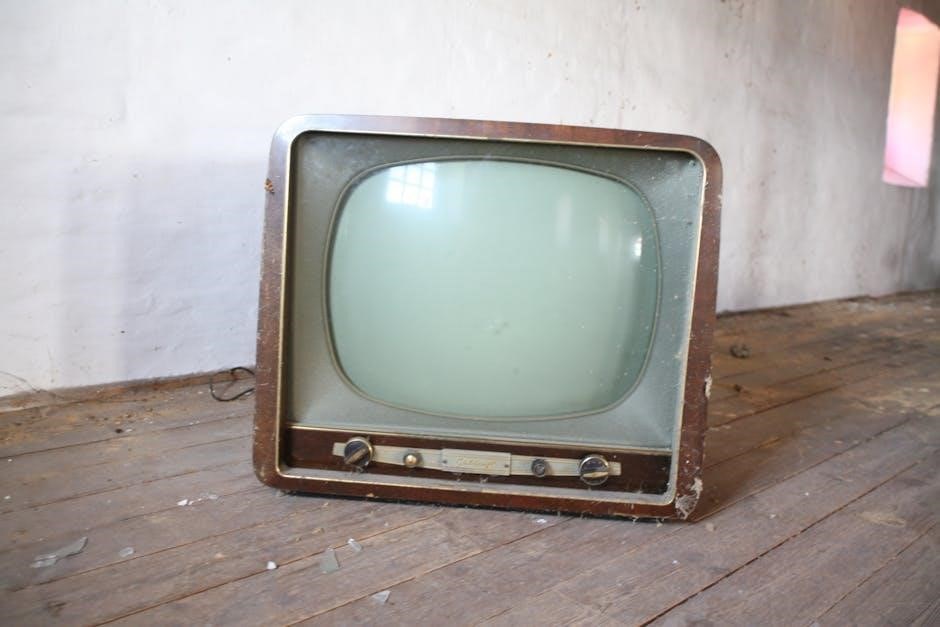TV Guide Magazine in 1966: A Comprehensive Overview
TV Guide in 1966 served as the dominant television listing publication, offering comprehensive program schedules and entertainment news․
A vast TV Guide cover archive, encompassing over 3,000 covers and spanning 60 years, is readily available for research․

Editions for regions like Northern California and North Texas from 1965-1970 are accessible, showcasing localized programming․
The February 12, 1966, North Texas edition, alongside others, provides a snapshot of the television landscape of that era․
Historical Context of 1966 Television
1966 marked a pivotal year in the evolution of American television, firmly establishing the medium as a central component of household life․ The “Golden Age of Television,” while waning, still boasted immensely popular programming, transitioning from live broadcasts to increasingly sophisticated filmed productions․ Network television – ABC, CBS, and NBC – held a near-monopoly on viewership, dictating schedules and shaping cultural trends․
Color television ownership was rapidly increasing, though still not ubiquitous; many households continued to watch in black and white․ This meant TV Guide had to cater to both audiences, often listing programs with notations indicating color broadcasts․ Popular genres included Westerns, sitcoms, variety shows, and detective dramas․ Shows like The Beverly Hillbillies, Bonanza, and The Red Skelton Show dominated the ratings․
The cultural climate of 1966 was one of significant change, with the Vietnam War escalating and the Civil Rights Movement gaining momentum․ Television began, albeit slowly, to reflect these societal shifts, though mainstream programming largely remained focused on escapism and family-friendly entertainment․ TV Guide, as a reflection of the times, provided a window into these evolving tastes and anxieties․
The Role of TV Guide in 1966
In 1966, TV Guide wasn’t merely a listing of programs; it was an indispensable cultural companion․ Before the advent of remote controls and on-screen program guides, it served as the primary source for viewers to plan their weekly television viewing․ Its detailed schedules, spanning multiple networks, were meticulously consulted by families across the nation․
Beyond listings, TV Guide offered a wealth of content, including articles, interviews with actors, and behind-the-scenes glimpses into popular shows․ It functioned as an early form of celebrity journalism, fueling public fascination with television personalities․ The magazine’s covers, featuring prominent stars, became iconic representations of the era․
Advertisements within TV Guide provided insights into the consumer products of the time, reflecting the economic and social landscape of 1966․ The magazine’s widespread circulation – reaching millions of households – made it a powerful advertising platform․ Essentially, TV Guide shaped not only what people watched, but how they watched it, solidifying its role as a central force in American popular culture․
TV Guide Cover Archive: Availability and Scope
A substantial TV Guide cover archive exists today, offering a fascinating visual record of television history․ This archive boasts over 3,000 covers, spanning six decades, and provides researchers and enthusiasts with a comprehensive resource․ Digitized collections are increasingly accessible online, allowing for easy browsing and exploration․

Specifically regarding 1966, the archive showcases the evolving aesthetic of the magazine, reflecting the changing styles and trends of the decade․ Covers from this year feature prominent stars of the era, offering a glimpse into the popular culture of the time․ The availability of these images allows for detailed study of cover design, typography, and photographic styles․
The scope extends beyond simply visual access; many archives also include metadata, such as publication dates and featured programs․ This information enhances the research value of the collection․ Resources like the Internet Archive contribute significantly to the preservation and accessibility of these historical TV Guide covers, ensuring their availability for future generations․
Regional Variations in TV Guide Editions (e․g․, Northern California, North Texas)
In 1966, TV Guide wasn’t a monolithic publication; significant regional variations existed to cater to local broadcasting schedules and viewer preferences․ Editions like those for Northern California and North Texas demonstrate this localized approach․ Programming differed substantially across the country due to network affiliations, independent stations, and time zone considerations․
The North Texas edition, for example, would list programs airing on Dallas-Fort Worth stations, while the Northern California version focused on the San Francisco Bay Area’s channels․ These differences extended beyond program listings to include local advertisements and regional entertainment news․ Even the cover artwork sometimes varied to feature personalities popular in specific areas․
Collectors actively seek out these regional editions, recognizing their value as historical artifacts․ They provide a unique window into the television landscape of specific communities in 1966․ The availability of editions spanning 1965-1970 for Northern California highlights the growing interest in preserving these localized snapshots of television history․
Popular Television Shows Featured in the February 12, 1966 Issue
The February 12, 1966, issue of TV Guide showcased the dominant television programs captivating audiences at the time․ While specific program details require accessing the issue itself, the era was defined by a blend of Westerns, sitcoms, and variety shows․ Popular series likely featured prominently included The Beverly Hillbillies, consistently a top-rated show, and Bonanza, a long-running Western staple․
Sitcoms like The Dick Van Dyke Show and Bewitched, both enjoying considerable success, would have been heavily advertised․ Daytime television was dominated by soap operas, and listings would reflect their daily broadcasts․ Variety shows, such as The Ed Sullivan Show, remained a significant draw, featuring a diverse range of performers․
The issue likely included previews of upcoming television movies and specials, alongside articles and interviews with prominent actors and actresses․ Examining the February 12th edition provides a direct glimpse into the programming preferences and viewing habits of American households in 1966․
Key Advertisements in the 1966 TV Guide
Advertisements within the 1966 TV Guide offered a fascinating window into the consumer culture of the era․ Full-page ads for household appliances, such as refrigerators and washing machines, were commonplace, reflecting the post-war boom and emphasis on modern convenience․ Automotive advertisements prominently featured the latest car models from Ford, Chevrolet, and Chrysler, showcasing their designs and features․
Food products, including processed foods and beverages, occupied significant advertising space, targeting the growing suburban families․ Tobacco advertising, though controversial by today’s standards, was prevalent, promoting cigarette brands with celebrity endorsements․ Pharmaceutical advertisements touted over-the-counter remedies for common ailments․
Beyond consumer goods, advertisements for television sets themselves were frequent, highlighting advancements in color television technology․ Department store ads promoted sales and special offers, enticing readers with a wide range of merchandise․ These advertisements collectively paint a vivid picture of the products and brands vying for the attention of American viewers in 1966․
Pricing and Distribution of TV Guide in 1966
In 1966, TV Guide was primarily distributed through newsstands, drugstores, and supermarkets, reaching a massive audience across the United States․ The magazine wasn’t initially a free publication; it was sold on a weekly basis, making it an accessible entertainment resource for most households․ The cover price of TV Guide in 1966 was typically 15 cents per issue, a relatively small investment for comprehensive television listings and celebrity features․
Distribution networks were well-established, ensuring widespread availability in both urban and rural areas․ Regional editions, like those for Northern California and North Texas, were tailored to local programming schedules and advertising․ This localized approach enhanced the magazine’s relevance and appeal to specific communities․
The consistent weekly release and affordable price point contributed to TV Guide’s remarkable circulation figures, solidifying its position as the leading source of television information during the mid-1960s․ It became a staple in American homes, influencing viewing habits and shaping popular culture․

TV Guide as a Cultural Artifact
TV Guide in 1966 transcended its function as a simple television listing; it became a significant cultural artifact, reflecting the societal values and entertainment preferences of the era․ The magazine offered a window into the programming landscape, showcasing the popular shows, stars, and trends that captivated the American public․
Its covers, now meticulously archived with over 3,000 examples, serve as visual representations of 1960s celebrity culture and television aesthetics․ Regional editions, like those from Northern California and North Texas, highlight the localized nuances of television broadcasting and regional tastes․
TV Guide also functioned as a platform for advertising, providing insights into the consumer products and lifestyles promoted during the period․ Today, collecting 1966 TV Guide issues is a popular hobby, allowing enthusiasts to reconnect with a bygone era of television history and cultural memory․ It’s a tangible link to a time when television was rapidly becoming a central force in American life․
Collecting 1966 TV Guides: A Hobbyist’s Guide

Collecting 1966 TV Guides offers a fascinating journey into television history and 1960s pop culture․ Key to a successful collection is understanding regional variations; editions from Northern California and North Texas, for example, possess unique appeal due to localized programming listings and advertisements․
Condition is paramount․ Issues in pristine, unread condition command higher values, though even well-preserved copies with minor wear are desirable․ Focus on complete issues, avoiding those with missing pages or significant damage․ The February 12, 1966, edition, and others featuring prominent stars, are particularly sought after․
Online resources, including the extensive TV Guide cover archive boasting over 3,000 covers, are invaluable for identifying specific issues and assessing their rarity․ Online marketplaces and vintage magazine dealers are primary sources for acquiring issues․ Careful preservation, using archival-quality sleeves and storage, will protect your investment and ensure its longevity․
The Design and Layout of the 1966 TV Guide
The 1966 TV Guide’s design reflected the mid-century modern aesthetic, prioritizing clarity and functionality alongside visual appeal․ Covers prominently featured photographs of popular television stars, often in vibrant color, designed to grab attention on newsstands․ The layout inside was meticulously organized, presenting daily television schedules in a grid format, easily navigable for viewers․
Typography was clean and legible, utilizing a mix of fonts to differentiate sections – program listings, articles, and advertisements․ Articles, covering entertainment news and celebrity profiles, were interspersed throughout the listings, providing engaging content beyond scheduling information․ Advertisements, a significant component, were integrated seamlessly, often reflecting the consumer culture of the era․
The magazine’s size and paper stock contributed to its tactile experience․ Examining archived copies reveals a consistent design language across regional editions, like those from Northern California and North Texas, with minor variations in local advertising․ The overall design aimed to be informative, visually appealing, and a trusted companion for television viewers․
Notable Actors and Actresses Featured in 1966 TV Guide
The 1966 TV Guide frequently showcased the biggest stars of the era, reflecting their prominence on television screens․ Actors like William Shatner, gaining recognition through Star Trek, and Dick Van Dyke, starring in his eponymous sitcom, graced the covers and filled interior pages with interviews and features․
Actresses such as Elizabeth Montgomery, captivating audiences as Samantha in Bewitched, and Lucille Ball, a television icon with The Lucy Show, were also prominently featured․ The magazine capitalized on their popularity, offering behind-the-scenes glimpses into their lives and careers․
Beyond established stars, TV Guide also highlighted emerging talents and supporting cast members from popular shows․ Coverage extended to actors appearing in dramas, comedies, and variety programs, providing a comprehensive overview of the television landscape․ The February 12, 1966, issue, and others from that year, served as a vital platform for promoting actors and actresses to a broad audience, solidifying their status as household names․
The Impact of TV Guide on Viewing Habits

In 1966, TV Guide exerted a significant influence on how Americans consumed television․ Before the advent of cable and streaming, it was the primary source for program schedules, effectively dictating viewing habits for millions of households․ Families routinely consulted TV Guide to plan their evenings, circling desired programs and coordinating around scheduled broadcasts․

The magazine’s detailed listings, coupled with program descriptions and star features, fostered anticipation and engagement with television content․ It wasn’t merely a schedule; it was a cultural touchstone, shaping conversations and creating shared viewing experiences․
TV Guide’s impact extended beyond simple scheduling․ It introduced viewers to new shows, highlighted upcoming specials, and provided a sense of control over the rapidly expanding world of television․ The publication’s widespread circulation and consistent presence in homes cemented its role as an indispensable companion to the television viewing experience in 1966․
Comparing TV Guide in 1966 to Modern TV Listings
Comparing TV Guide in 1966 to contemporary TV listings reveals a dramatic shift in how viewers access program information․ The 1966 TV Guide was a weekly print publication, offering a static schedule for a fixed period․ Modern listings, conversely, are largely digital, dynamic, and personalized․
Today’s viewers utilize on-screen guides, streaming service interfaces, and mobile apps that provide real-time updates and recommendations․ The sheer volume of content available now dwarfs the limited broadcast options of 1966, necessitating sophisticated search and filtering tools․
While TV Guide offered program descriptions and star features, modern listings often include trailers, reviews, and social media integration․ The interactive nature of digital listings allows viewers to record programs, set reminders, and share viewing choices․ The printed TV Guide fostered a communal viewing experience; modern listings cater to individual preferences and on-demand consumption․
Online Archives and Resources for 1966 TV Guides
Several online resources provide access to TV Guide magazines from 1966, catering to researchers, collectors, and nostalgia enthusiasts․ The Internet Archive hosts digitized copies of TV Guide editions, including those from Northern California (1965-1970) and the North Texas edition of February 12, 1966․
Dedicated websites and online communities, like the ORIGINAL TV Archive Facebook Group, facilitate the sharing of scans and information about vintage TV Guide issues․ These platforms often feature extensive cover archives, boasting over 3,000 covers spanning 60 years․
Furthermore, platforms like eBay and online auction sites frequently offer original 1966 TV Guide magazines for sale․ These resources allow users to explore the publication’s content, advertisements, and cultural context, offering a glimpse into the television landscape of the mid-1960s․ Digital preservation efforts continue to expand the availability of these historical documents․
The Original TV Archive and TV Guide Information
The ORIGINAL TV Archive, particularly its active Facebook Group, stands as a central hub for enthusiasts seeking information and scans of vintage TV Guide magazines, including those from 1966․ This community, explicitly stating “Accept NO Substitutes!”, prioritizes authentic archival material and collaborative sharing․
Members frequently contribute digitized issues, cover images, and discussions surrounding the television programming and cultural trends reflected in TV Guide during that era․ The archive’s focus extends beyond simple listings, encompassing advertisements, articles, and the overall design aesthetic of the publication․
Information shared within the group often details regional variations, such as the Northern California and North Texas editions, providing insights into localized broadcasting schedules․ The archive serves as a valuable resource for researchers and collectors interested in the history of television and popular culture, offering a dynamic platform for preserving and accessing TV Guide’s legacy․
Software for TV Boxes and Streaming in 2024-2025 (Related to Accessing Content)
While directly linking 1966 TV Guide content to modern streaming software seems paradoxical, the core function – accessing television programming – remains relevant․ Today’s TV boxes and streaming platforms offer functionalities mirroring TV Guide’s original purpose: discovering and scheduling viewing․

Software like BrowseHere, a refined browser for TCL and Android TVs, provides an ad-free streaming experience․ MXPlayer and KMPlayer, versatile media players, support numerous formats, enabling playback of archived television content if sourced digitally․ These aren’t direct replacements for a printed TV Guide, but facilitate content access․

Furthermore, applications for installing APK files onto TV boxes allow users to customize their viewing experience․ The need for reliable software is highlighted by the shifting landscape of streaming services, mirroring the evolving television schedules TV Guide once meticulously documented․ Ultimately, these tools empower viewers to navigate the modern television world, echoing TV Guide’s historical role․
Media Players Compatible with TV Boxes (e․g․, MXPlayer, KMPlayer)

Considering the context of a 1966 TV Guide, the concept of media players on TV boxes seems anachronistic․ However, if one were to digitally archive issues of TV Guide and wish to view them on a modern TV, compatible media players become essential․
MXPlayer stands out as a highly versatile option, supporting a wide array of video and audio formats․ Its ability to handle various codecs is crucial for playing potentially older, digitally converted TV Guide content․ KMPlayer, similarly, offers extensive format support and plugin capabilities, enhancing playback options․
These players aren’t about accessing live television listings like the 1966 TV Guide provided, but rather about displaying archived content․ The ability to access computer shared folders, as MXPlayer offers, is valuable for accessing digital TV Guide collections․ While seemingly distant from the original publication’s purpose, these players bridge the gap between historical print media and modern display technology․
Alternatives to TV Guide for Finding TV Listings Today
In 1966, TV Guide reigned supreme as the primary source for television schedules․ Today, the landscape is vastly different․ Numerous digital alternatives have emerged, rendering the printed TV Guide largely obsolete for immediate listing needs․
Streaming services like Hulu, Netflix, and Amazon Prime Video offer integrated program guides within their platforms․ Dedicated websites and apps, such as TVTime and Reelgood, aggregate listings from multiple streaming services and broadcast channels․ These platforms often personalize recommendations based on viewing history․
Furthermore, smart TV operating systems typically include built-in program guides․ Browsers like BrowseHere, specifically designed for Android TVs, provide ad-free access to online content․ While these modern options lack the nostalgic charm of a 1966 TV Guide, they offer convenience and comprehensive coverage․ The shift reflects a move from passive schedule consumption to on-demand, personalized viewing experiences․
